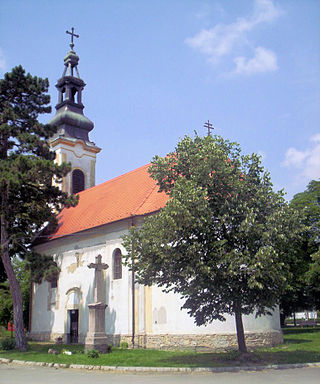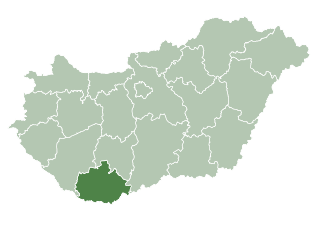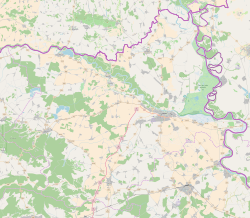
The Danube Swabians is a collective term for the ethnic German-speaking population who lived in the Kingdom of Hungary in east-central Europe, especially in the Danube River valley, first in the 12th century, and in greater numbers in the 17th and 18th centuries. Most were descended from earlier 18th-century Swabian settlers from Upper Swabia, the Swabian Jura, northern Lake Constance, the upper Danube, the Swabian-Franconian Forest, the Southern Black Forest and the Principality of Fürstenberg, followed by Hessians, Bavarians, Franconians and Lorrainers recruited by Austria to repopulate the area and restore agriculture after the expulsion of the Ottoman Empire. They were able to keep their language and religion and initially developed strongly German communities in the region with German folklore.

Baranya was an administrative county (comitatus) of the Kingdom of Hungary. Its territory is now divided between present-day Baranya County of Hungary and Osijek-Baranja County of Croatia. The capital of the county was Pécs.

Bóly is a town in Baranya County, Hungary. Today Hungarian, the town was historically home to a large Danube Swabian population.

Hercegszántó is a village in the Bács-Kiskun County of Hungary, famous for being the birthplace of footballer Flórián Albert. Residents are Magyars, with minority of Serbs and Croats. Until the end of World War II, the Danube Swabians lived in this village, it was the only village of Stifulder, in the Bács-Kiskun county. The Stifulder are a Roman Catholic subgroup of the Danube Swabians whose ancestors arrived in the 17th and 18th centuries from Fulda (district). Majority of the Danube Swabians was expelled to Allied-occupied Germany and Allied-occupied Austria in 1945–1948, as a result of the Potsdam Agreement.

Beremend is a village in Baranya County, Hungary on the Croatian border, it constitutes the southernmost point of the country. Residents are Hungarians, with minority of Serbs.

Illocska,, is a village in Baranya county, Hungary. Residents are Magyars, with a minority of Serbs and Danube Swabians. Until the end of World War II, the majority of the inhabitants were Roman Catholic Danube Swabians (Schwowe), their ancestors arrived in 1790 from Nagyszékely and Gyönk villages to Illocska. Most of the former German settlers were expelled to allied-occupied Germany and allied-occupied Austria in 1946–1948, following the Potsdam Agreement. Only a few Germans of Hungary live there, the majority today are the descendants of Hungarians from the Czechoslovak–Hungarian population exchange. They got the houses of the former Danube Swabian Inhabitants.

Kisjakabfalva is a village in Baranya county, Hungary. Until the end of World War II, the majority of the inhabitants were Danube Swabians, also called locally as Stifolder, because their ancestors arrived in the 17th and 18th centuries from Fulda (district). Most of the former German settlers were expelled to Allied-occupied Germany and Allied-occupied Austria in 1945–1948, as a result of the Potsdam Agreement. Only a few Germans of Hungary live there, the majority today are the descendants of Hungarians from the Czechoslovak–Hungarian population exchange. They occupied the houses of the former Danube Swabian inhabitants.

Kiskassa is a village in Baranya county, Hungary. It is located 17 kilometers to the south-east of the city Pécs, the capital city of Baranya. Until the end of World War II, the majority of the inhabitants was Danube Swabian, also called locally as Stifolder, because their ancestors had arrived in the 17th and 18th centuries from Fulda (district). Most of the former German settlers were expelled to Allied-occupied Germany and Allied-occupied Austria in 1945–1948, under the Potsdam Agreement. Only a few Germans of Hungary live there, the majority today are the descendants of Hungarians from the Czechoslovak–Hungarian population exchange. They got the houses of the former Danube Swabian inhabitants.

Majs is a village in Baranya County, Hungary. Residents are Magyars, with a minority of Danube Swabians and Serbs.

Palkonya is a village in Baranya County, Hungary. This village was once settled by Turks in Hungary until 1699 and the church was once a mosque. Until the end of World War II, the majority of the inhabitants was Danube Swabian, also called locally as Stifolder, because their ancestors arrived in the 17th and 18th centuris from Fulda (district). Most of the former German settlers were expelled to Allied-occupied Germany and Allied-occupied Austria in 1945–1948, consequent to the Potsdam Agreement. Only a few Germans of Hungary live there, the majority today are the descendants of Hungarians from the Czechoslovak–Hungarian population exchange. They got the houses of the former Danube Swabian inhabitants.

Udvar is a village in Baranya county, Hungary. The village is located near the Danube River. Until the end of World War II, the inhabitants were Danube Swabians, also called locally as Stifolder, because their ancestors arrived around 1720 from Fulda (district). Most of the former German settlers were expelled to Allied-occupied Germany and Allied-occupied Austria in 1945–1948, under the Potsdam Agreement. Only a few Germans of Hungary live there, the majority today are the descendants of Hungarians from the Czechoslovak–Hungarian population exchange. They occupied the houses of the former Danube Swabian inhabitants.
Ivánbattyán is a village in Baranya county, Hungary. Until the end of World War II, the inhabitants were Danube Swabians, also called locally as Stifolder, because their ancestors arrived in the 17th and 18th centuries from Fulda (district). Most of the former German settlers were expelled to allied-occupied Germany and allied-occupied Austria in 1945–1948, as a result of the Potsdam Agreement. Only a few Germans of Hungary live there, the majority today are the descendants of Hungarians from the Czechoslovak–Hungarian population exchange. They occupied the houses of the former Danube Swabian inhabitants.

Kisbudmér is a village and municipality in Baranya county, Hungary.

Lippó is a village in Baranya county, Hungary. Residents are Magyars, Germans of Hungary, with minority of Serbs. Until the end of World War II, the majority of the inhabitants were Danube Swabians, also called locally as Stifolder, because their ancestors arrived in the 17th and 18th centuries from Fulda (district). Most of the former German settlers were expelled to allied-occupied Germany and allied-occupied Austria in 1945–1948, under the Potsdam Agreement. Only a few Germans of Hungary live there, the majority today are the descendants of Hungarians from the Czechoslovak–Hungarian population exchange. They occupied the houses of the former Danube Swabian inhabitants.

Lánycsók is a village in Baranya County, Hungary.
Monyoród is a village and municipality in Baranya County, Hungary. Until the end of World War II, the majority of the inhabitants was Danube Swabian, also called locally as Stifolder, because their ancestors arrived in the 17th and 18th centuries from Fulda (district). Most of the former German settlers were expelled to allied-occupied Germany and allied-occupied Austria in 1945–1948, as a result of the Potsdam Agreement. Only a few Germans of Hungary live there, the majority today are the descendants of Hungarians from the Czechoslovak–Hungarian population exchange. They occupied the houses of the former Danube Swabian inhabitants.

Pócsa is a village and municipality in Baranya county, Hungary. Residents are Magyars, with minority of Germans. Until the end of World War II, the inhabitants' majority was Danube Swabian, also called locally as Stifolder, because their ancestors arrived in the 17th and 18th centuries from Fulda (district). Most of the former German settlers were expelled to Allied-occupied Germany and Allied-occupied Austria in 1945–1948, as a result of the Potsdam Agreement. Only a few Germans of Hungary live there, the majority today are the descendants of Hungarians from the Czechoslovak–Hungarian population exchange. They got the houses of the former Danube Swabian inhabitants.

Töttös is a village in Baranya county, Hungary. Until the end of World War II, the majority of the inhabitants was Danube Swabian, also called locally as Stifolder, because their ancestors arrived in the 17th and 18th centuries from Fulda (district). Most of the former German settlers were expelled to allied-occupied Germany and allied-occupied Austria in 1945–1948, pursuant to the 1945 Potsdam Agreement. Only a few Germans of Hungary live there, the majority today are the descendants of Hungarians from the Czechoslovak–Hungarian population exchange. They occupied the houses of the former Danube Swabian inhabitants.
Vokány is a village in Baranya County, Hungary. Until the end of World War II, the inhabitants were Danube Swabians, also called locally as Stifolder, because their ancestors arrived around 1720 from Fulda (district). Most of the former German settlers were expelled to Allied-occupied Germany and Allied-occupied Austria in 1945–1948, under the Potsdam Agreement. Only a few Germans of Hungary live there, the majority today are the descendants of Hungarians from the Czechoslovak–Hungarian population exchange. They obtained the houses of the former Danube Swabian inhabitants.
Újpetre is a village in Baranya county, Hungary. Until the end of World War II, the inhabitants were Danube Swabians, also called locally as Stifolder, because their ancestors arrived around 1720 from Fulda (district). Most of the former German settlers were expelled to Allied-occupied Germany and Allied-occupied Austria in 1945–1948, following the Potsdam Agreement. Only a few Germans of Hungary live there, the majority today are the descendants of Hungarians from the Czechoslovak–Hungarian population exchange. They occupied the houses of the former Danube Swabian inhabitants.















